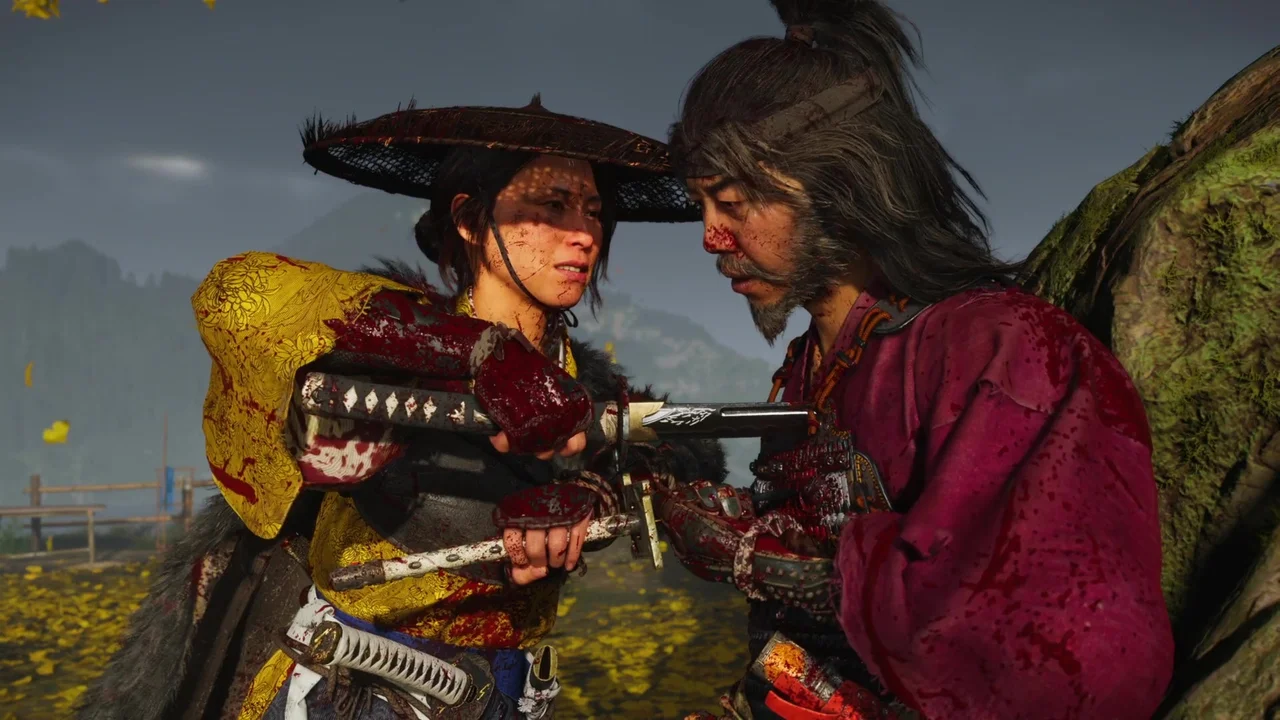It all begins beneath a silent gingko tree. Sixteen years after her family was slaughtered, Atsu stands where it all began, at her childhood home, now a battlefield soaked in memory and blood. The story of Ghost of Yotei doesn’t just end here; it transforms. This isn’t another revenge tale. It’s the moment where vengeance, peace, and destiny collide. Here is the complete ghost of yotei ending explained.
The Last Battle: Where Revenge Meets Reflection
The final showdown between Atsu and Lord Saito is brutal, personal, and poetic. Beneath the same gingko tree where she was once left for dead, Atsu finally strikes her enemy down, driving him into the trunk with her sword, just as he had done to her parents years ago.
But this victory tastes of iron and tears. Jubei, Atsu’s loyal brother and the only family she had left, is fatally wounded. As he takes his last breath, he whispers the name of his daughter, Kiku. Atsu promises to protect her niece, never letting her face the loneliness that once consumed her own soul.
And then, the most haunting scene: Atsu faces her younger self, bloodied, broken, and crying. She embraces that child. The past and present merge… and the child becomes Kiku. The cycle of grief starts to break.
Six Months Later: From Blood to Blossoms
Time softens the battlefield. Six months pass, and Atsu tends the same fields she once foraged with Jubei. But he isn’t there, only a fading vision, replaced by Kiku. Together, they gather mushrooms, laugh, and plant hope in soil once fed by sorrow.
Kiku shows Atsu a field of flowers, kiku blossoms, Jubei’s favorite. Atsu explains that the flowers carry his name, symbolizing the rebirth of her family’s peace. The past is no longer a wound; it’s a memory finally allowed to heal.
When they return home, Kiku plays the shamisen alongside Oyuki. Atsu brings one of the flowers to Jubei’s grave, telling him about his daughter’s growing strength and music. But then, the wolf appears.
The Wolf and the Onryo: The End of Vengeance
Throughout the game, the wolf followed Atsu like a ghost, fierce, loyal, yet filled with rage. Now, it returns calm and silent. No snarling, no anger. Atsu strokes its head gently. The beast whimpers once and walks away.
This moment is more than symbolic, the wolf is Atsu’s rage, her Onryo spirit of vengeance. By letting it go, she releases the fury that once defined her. The Onryo is gone. What remains is simply Atsu, a woman who has survived grief and found purpose beyond it.
She turns toward Oyuki and Kiku, whispers softly:
“My hunt is over.”
The screen fades, the music stills, and the player realizes something rare, a revenge story that doesn’t end in darkness, but in light.
The Meaning Behind the Ending
At its heart, the Ghost of Yotei ending shows that vengeance doesn’t have to define you. Lord Saito dies alone, trapped by the same blade and tree that once marked his cruelty. Atsu, on the other hand, walks away surrounded by love.
Even the swords themselves carry meaning. Saito’s katana — Tiger’s Fang — was forged by Atsu’s father. The weapon that once symbolized betrayal becomes the very tool of justice, ending the legacy of pain it began. It’s storytelling symmetry at its finest.
Atsu’s transformation is complete. She was once consumed by revenge. Now, she becomes a guardian, a mother figure to Kiku, breaking the generational curse of rage that haunted both her and Saito’s bloodline.
After the Credits: The Hunt Continues
The credits roll, but the story doesn’t end. We see Atsu and Kiku sitting peacefully at home. Kiku asks her aunt to tell a story, one from her time as the Onryo. Here, the player can revisit unfinished quests labeled Unfinished Business, traveling back six months before the final battle.
It’s poetic. The game lets you live between revenge and redemption, the two sides of Atsu’s soul.
Ghost of Yotei vs. Ghost of Tsushim
If Ghost of Tsushima was about embracing the “Ghost,” Ghost of Yotei is about leaving it behind. Jin Sakai becomes the symbol his people need, while Atsu chooses her family over legend. Her burning of the Onryo sash without crossing out Saito’s name proves that peace is found not in revenge, but in letting go.
| Character | Symbolic Choice | Result |
|---|---|---|
| Atsu (Ghost of Yotei) | Rejects Onryo spirit | Finds peace & family |
| Jin Sakai (Ghost of Tsushima) | Becomes the Ghost | Protects his people |
Atsu’s journey closes with life blooming again, her heart free, her blade at rest.
The Hunt Ends, The Heart Heals
The Ghost of Yotei ending is not just an end. It’s a message: revenge might begin your story, but it doesn’t have to finish it. Atsu proves that even in a world soaked with blood, compassion can still bloom. The wolf walks away. The Onryo fades. And in that quiet, Atsu finally becomes human again.
Suggested Read: Blue Prince Ending Explained: The Truth About Room 46







